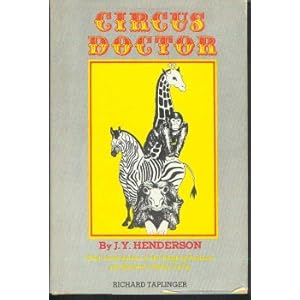I've never really liked circuses; the massive Ringling operation, the folksy modern-day tent shows, and the animal-less Cirque all leave me cold. That is, the shows leave me cold. The idea of being part of the circus, on the other hand, is fabulous. All that color and drama to take you away from drab and sordid reality. From Toby Tyler to The Greatest Show On Earth, I've always been a sucker for a circus story.
Plus, classic circus stories are like Westerns; even when they're bad, they have horses.

Circus Doctor
J.Y. Henderson, told to Richard Taplinger
1951, Little, Brown and Company
... the circus's biggest preoccupation was with its horses: Ringling Brothers had a fortune tied up in what was undoubtedly the most beautiful collection of horses in the world. They wanted everything possible done for the rest of their animals too, but experience had taught them that they couldn't expect that to be too much.
In September, 1941, John Ringling North called a young veterinarian and offered him a job. The vet, Henderson, was a partner in a mixed small/large animal practice in
In Ringling Brothers - Barnum & Bailey's winter quarters in Sarasota, Henderson is wary of his new, dangerous charges and takes comfort in the familiar:
On three sides of us there were open stalls, and on the fourth were box stalls where the most favored horses were kept. In the immediate center of the corral were patches of grass decorated with palm trees and a large watering trough... I examined the broad-beamed Percherons, smaller neat hackneys, smart American saddle horses, wild Arabians, the standard-bred horses, stockinged Clydesdales, and Andalusians.
Of course,
The busiest place in the world is not a beehive. It is not found by watching the ways of an ant, nor is it an army preparing for an invasion. The busiest place on earth is the grounds of a gigantic circus, two weeks before hitting the road for an eight-month season.
In that first year, with the value of vaccinations still in question,
While the pen boys stood there laughing, the two llamas chased me all over the pen. I was chastened and emerged unvictorious after being sprayed by both of them from head to foot.
Then there's the frankly alarming camel story, which I don't particularly care to relate in detail. Suffice it to say, camels appear to be extremely open-minded about personal matters most animals tend to regard with a great deal of jealousy.
I'd gladly walk a mile to keep from operating on a camel.
A year after he joins the circus,
I knew then there is something in animal make-up akin to greatness in men. It is not just their size or their swiftness; their fierceness or their power. There is an inner nobility and a kinship to what is enduring in nature.
This is a essentially a collection of moments connected by quick throwaway lines about non-circus life.
And finally, it is a testament to the power of horses to do truly odd, arguably idiotic things that in a book filled with escaping lions, runaway giraffes and very angry gorillas, many of the most memorable mishaps have to do with the horses. A saddle horse, waiting on the ramp into
Links
Billboard magazine article about the
Buckles Blog - covers circus history, features a photo of McClain's elephants
Buckles Blog - photo of
The Greatest Show On Earth (1952) - IMDB
Other equine info
Name-dropping
John Ringling North - owner of the circus
Dr. J.K. Northway - vet of the King Ranch
Damoo Dhotre - trainer
John Sabo - menagerie superintendent
Dick Clemens - cat trainer
Walter McClain - elephant trainer
Rudolph Mathies - tiger trainer
Justino Loyal - horse act



No comments:
Post a Comment